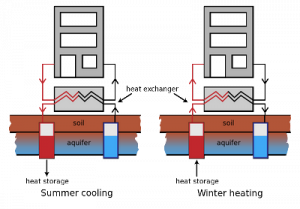EnergyStoring renewable energy underground for a reliable, affordable national grid
A common criticism of a total transition to renewable energy — wind, water, and solar power — is that the U.S. electrical grid cannot affordably store enough standby electricity to keep the system stable. Researchers propose an underground solution to that problem. The researchers use data from single-state calculations of the number of wind, water, and solar generators potentially needed in each state to show that these installations can theoretically result in a reliable, affordable national grid when the generators are combined with inexpensive storage and “demand response” — a program in which utilities give customers incentives to control times of peak demand.

Schematic illustration of underground thermal storage // Source: stanford.edu
Over the last few years, Mark Jacobson, a Stanford professor of civil and environmental engineering, and his colleague, Mark Delucchi of the University of California, Berkeley, have produced a series of plans, based on huge amounts of data churned through computer models, showing how each state in America could shift from fossil fuel to entirely renewable energy.
In a new study published in Proceedings of the National Academy of Sciences, they use the data from those single-state calculations of the number of wind, water and solar generators potentially needed in each state to show that these installations can theoretically result in a reliable, affordable national grid when the generators are combined with inexpensive storage and “demand response” — a program in which utilities give customers incentives to control times of peak demand.
An underground effort
Stanford U reports that the proposed system relies on the ability to store and retrieve heat, cold and electricity in order to meet demand at all times.
Summer heat gathered in rooftop solar collectors could be stored in soil or rocks and used for heating homes in winter. Excess or low-cost electricity could be used to make ice, which would be used for later cooling when the price of electricity is high.
Excess electricity could also be used to make more electricity, by supplementing the energy-producing mechanisms that drive concentrated solar power plants and pumped hydroelectric facilities. Utilities would also provide incentives to reduce energy use during times of peak demand.
In Jacobson’s plan, hydrogen would also be used as a storage medium; during low-demand hours, excess electricity would be used to create hydrogen, which could be stored in fuel cells and used to power some vehicles.
Jacobson’s new model foresees, and is dependent upon, an all-electric country, with virtually everything running 100 percent on electricity: cars, trains, buses, industry, heating, and cooling, and with the electricity originating from wind, water and sunlight.
There would be no need for coal, natural gas, biofuels, nuclear power, or enormous battery farms for storing electricity. Such a world, which would be 100 percent clean by 2050, can result in a stable grid, he said.
